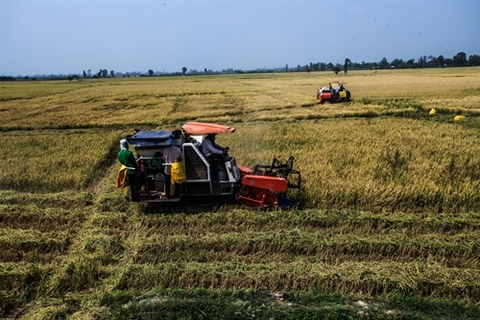 |
| A farmer harvests rice in the Cuu Long (Mekong) Delta. Viet Nam was one of the leading rice exporters in the world in 2015, with an 18.3 per cent market share. — VNA/VNS Photo Trong Dat |
HAU GIANG (Biz Hub) — Inventing and applying new technologies has become an urgent task for Vietnamese businesses amid the country's international integration, especially in agriculture, a conference heard in the Cuu Long (Mekong) Delta province of Hau Giang yesterday.
"This year, the national technology map for rice seed selection will be completed," Ta Viet Dung, head of the Ministry of Science and Technology's Technology Application and Development Department told the event held to discuss Supporting, Promoting Technology Application and Innovation by Enterprises under the Value Chain.
"The map will enable relevant authorities to set up strategy, policy and technology programmes and improve companies' competitiveness."
Tran Duy Quy from the department said, "Rice seed selection technology has significantly increased rice capacity from three tonnes per hectare in 1986 to 5.77 tonnes in 2015."
Last year 255 rice strains were grown on Viet Nam's 7.66 million hectares of paddies, with 66 of them – including five stick rice varieties and 15 hybrids — accounting for 91 per cent of the area.
The annual demand for rice seeds is around 1.2 million tonnes, with almost three-fourths of it from the Mekong Delta.
"Now Viet Nam is able to meet 100 per cent of its normal seed demand, and imports US$35 million worth of hybrid seeds," Quy said.
Seventeen institutes, universities and enterprises are creating new rice strains.
"There are a lot of new rice seeds created by them but only some survive and it is hard to control their quality during cultivation," Quy said.
With most rice strains being indigenous, they fetch low prices, he said, pointing out that no Vietnamese seed brands are exported.
Vietnamese scientists and researchers need to create rice strains that can resist diseases, drought, flooding and salinity, he said. "Viet Nam only has 38 – 61 per cent of the modern technologies required to create new seeds."
He suggested instituting a national programme to develop quality rice seeds by 2035.
"The Government should offer incentives to attract private enterprises into research, strengthen copyright protection, set up exhibition areas in various places and assist enterprises with human resource training and international co-operation."
In 2015 Viet Nam was one of the leading rice exporters in the world with an 18.3 per cent market share, mainly focusing on cheap varieties and shipping 6.56 million tonnes for $2.68 billion.
"There are a lot of seeds in Viet Nam but none would be good enough to produce the best rice," Dao The Anh, deputy head of the Field Crops Research Institute, said.
"Most post-harvest technologies are backward and [as a result] production of rice by-products is low.
"Technologies required for the whole rice production process, from cultivation and harvesting to preservation, must be boosted to meet the development needs," he said. — VNS